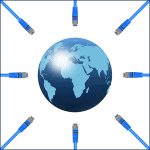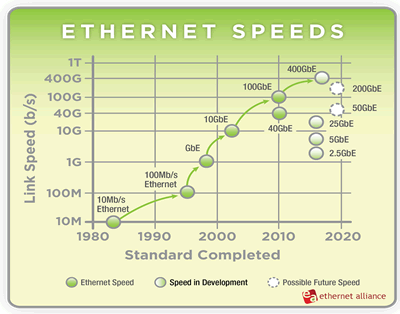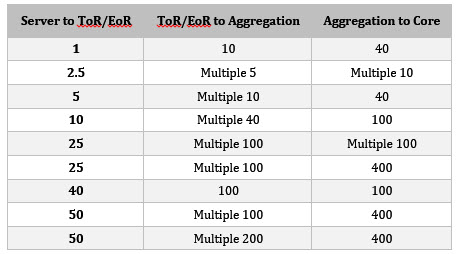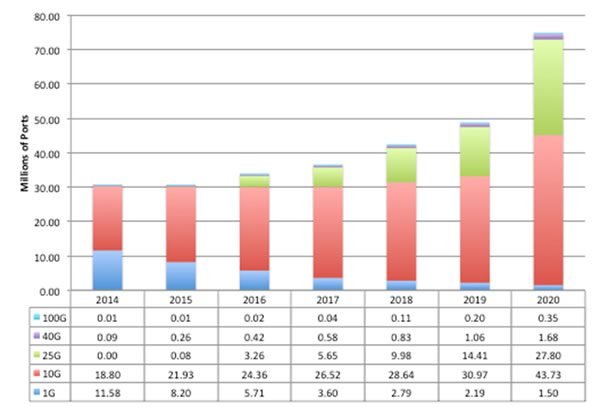Local Area Networking – the New Ethernet Paradigm
400G, 100G, 50G, 25G, 10G, 5G, 2.5G, 1G: What combination of data rates is right for your LAN?
†
 Ethernet has dominated data communications for a very long time. In the next few years, we do not expect this to change but, in fact, to proliferate. Today and in the near future, there will be so many options for Ethernet that it may be overwhelming for IT professionals to sort through what is right for their networks. The upgrade paths are many and diverse. Let’s summarize and clarify the options.
Ethernet has dominated data communications for a very long time. In the next few years, we do not expect this to change but, in fact, to proliferate. Today and in the near future, there will be so many options for Ethernet that it may be overwhelming for IT professionals to sort through what is right for their networks. The upgrade paths are many and diverse. Let’s summarize and clarify the options.
The IEEE 802.3 Standards Committee controls the standards that are written for Ethernet. It has various projects in the pipeline as shown in the following diagram.

Figure 1: Ethernet data rate roadmap (Source: Ethernet Alliance)
While 10G-and-below data rates have seen widespread adoption, 40G and 100G are just now starting to make an impact primarily in the data center. Both higher and lower data rates are in development. While 2.5G and 5G standards are being settled to support connections for wireless access points (WAP), products compliant with these standards may also see some level of design-in at the server level. Consequentially, even though 25G products are first targeted at server connections, they may also wind up becoming a connection between top-of-rack (ToR) switch and aggregation switch.
Bishop & Associates contends that small- and medium-sized businesses that may not have the IT budget or the need for 10G connections at the server may adopt more cost-effective 2.5G and 5G solutions from server to ToR switch and 10G or 25G uplinks from there. This path allows for reuse of some – if not all – existing cabling infrastructure. In fact, Cisco Catalyst 4500E, 3850, and 3560-CX already have these ports to support WAPs. The next logical step would be to extend these to server connections.
Large enterprises and Internet data centers (also called cloud providers) are expected to take the higher data rate route. The most likely upgrade paths are shown in the table below.

While it is still too early to predict the progression of 2.5G and 5G inside the LAN and data center, 25G has a clear place. The following chart shows the anticipated rapid deployment. It shows a snapshot of the most logical progression of server connections if 2.5G and 5G do not become part of the wired data center.

Figure 2: Server data rate deployment (Source: Discerning Analytics, LLC)
In 2010, it was believed that the upgrade path for servers would be from 10G to 40G, but this has failed to materialize primarily due to two factors – high cost and no clear uplink strategy. In other words, if a server is connected to a ToR switch at 40G, what data rate do you use to connect ToR switch to aggregation switch for effective network operation? Would it just be multiple 40G or 100G? There are inherent cost and bandwidth-matching issues with both scenarios; therefore, very little adoption of 40G at the server has occurred. But, with 25G, simple four-to-one uplinks of 100G can be made – the main reason why Microsoft spearheaded its development, first outside the IEEE and then from within. In fact, Brad Booth, principal engineer at Microsoft, detailed its strategy in late 2014 as “crop rotation. Right now, we’re building out 10G at the server with 40G in the core of the network. The next step will be 25G at the server and 100G at the core.”
The new 2.5G, 5G, and 25G will first be implemented for copper cabling. All three will have balanced twisted-pair category cabling solutions and, in addition, 25G will have a twinax version. While 2.5G and 5G will run on an installed base of Category 5e or 6, 25G is expected to need the newly designed Category 8. Currently, the IEEE is not working on a fiber version for 2.5G and 5G, but 25G will have a multi-mode fiber (MMF) solution.
The bottom line on Ethernet data rates will be entirely up to each individual company’s needs. Small firms will tend to stick with cost-effective, lower-data-rate options, while those running their businesses on the Internet will be the early adopters of higher ones.
Fiber optic connectors are finding application in every market sector, and are forecast to be one of the highest growth connector types over the next 5-years. For more information on growth in the fiber optic connector market, see Bishop & Associates recent study The Fiber Optic Connector Market 2015-2020.




